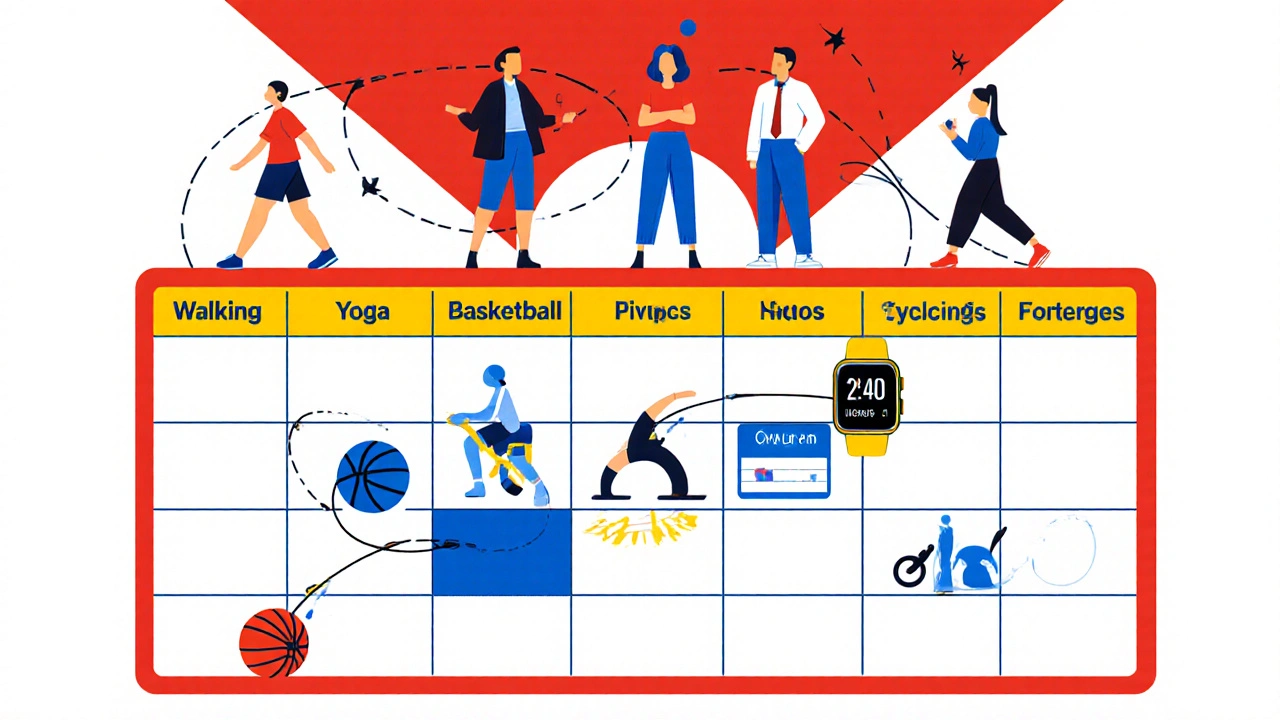Tremor-Friendly Activity Recommender
Find Your Perfect Activity
Answer these questions to get personalized recommendations for tremor-friendly sports.
Your Personalized Recommendations
Based on your inputs, here are activities that work best for you.
Living with tremors doesn’t have to mean giving up the games you love. Whether you’re dealing with essential tremor, Parkinsonian shaking, or occasional tremors from medication side‑effects, there are practical ways to stay in the mix, keep fit, and still have fun on the field.
Key Takeaways
- Identify which type of tremor you have and how it affects specific movements.
- Pick sports and exercises that naturally dampen shaking or can be easily adapted.
- Use simple gear tweaks, wearable tech, and timing strategies to boost control.
- Plan warm‑up, hydration, and recovery routines that reduce tremor intensity.
- Lean on professionals-physiotherapists, coaches, and support groups-to keep motivation high.
Understanding Tremors and Their Impact on Sports
Tremors are involuntary, rhythmic muscle contractions that cause shaking of one or more body parts. They can be resting, postural, or action‑related, and severity varies from barely noticeable to disabling. The two most common medical causes are Essential tremor, a hereditary condition that typically affects the hands and head, and Parkinsonian tremor, which often starts on one side and worsens with stress. Knowing the pattern of your tremor helps you pick activities that either avoid aggravating the motion or use the movement to your advantage.
Choosing Tremor‑Friendly Activities
Some sports naturally dampen shaking because they rely on larger muscle groups, rhythmic pacing, or low‑impact motions. Here are a few that work well for most tremor profiles:
- Walking or Nordic walking - steady, rhythmic steps engage the core and lower limbs, keeping hand tremor less noticeable.
- Swimming - buoyancy reduces joint stress, and the propulsive kick works against tremor‑induced arm wobble.
- Cycling (stationary or outdoor) - leg power dominates; you can grip handlebars with adaptive grips.
- Yoga and Pilates - focus on balance and breath, which often lowers stress‑related tremor spikes.
- Adaptive team sports such as wheelchair basketball or seated volleyball - these modify hand demands and emphasize strategic positioning.
If you prefer high‑intensity cardio, try interval training that alternates short bursts (where tremor might spike) with longer recovery phases. The key is to monitor how your tremor reacts to each phase and adjust accordingly.

Adapting Your Training Routine
Even a sport you love can become more manageable with a few tweaks:
- Warm‑up wisely. A 10‑minute warm‑up that gradually raises heart rate-light jogging, dynamic stretches-has been shown to reduce tremor amplitude by up to 15% in a small 2023 physiotherapy study.
- Timing matters. Schedule workouts when medication peaks are at their highest efficacy. For beta‑blocker users, mid‑morning often aligns with optimal tremor control.
- Use assistive grips. Silicone or weighted handles increase friction and provide proprioceptive feedback, helping steady the hand.
- Break tasks into chunks. Instead of a continuous 30‑minute basketball drill, do three 10‑minute sets with 2‑minute rests to prevent fatigue‑driven shaking.
- Focus on form over speed. Slow, controlled movements train the nervous system to compensate for tremor, improving overall coordination.
These adjustments turn shaky moments into training data for your brain, gradually refining motor pathways.
Gear and Technology to Help
Modern wearables aren’t just for tracking steps-they can be tremor‑management tools.
| Device / Gear | Primary Benefit | Best For |
|---|---|---|
| Weighted wrist bands | Increases proprioceptive input, dampens hand tremor | Strength training, weightlifting |
| Anti‑vibration gloves | d>Reduces vibration transmission during racket sportsTennis, badminton | |
| Smartwatch with tremor monitoring | Logs tremor frequency, alerts when intensity spikes | All‑day activity tracking |
| Adaptive bike grips (silicone) | Improves hand stability on handlebars | Cycling, stationary bike |
Many athletes also benefit from Wearable technology that offers real‑time bio‑feedback, letting you pause the session the moment tremor reaches a pre‑set threshold.

Managing Symptoms Before, During, and After Exercise
When tremors flare, it’s often linked to stress, caffeine, or low blood sugar. Here’s a simple tremor-friendly workouts checklist you can follow:
- Hydrate: Aim for 500 ml of water 30 minutes before activity.
- Snack smart: A banana or a handful of nuts stabilizes glucose levels.
- Avoid stimulants: Limit coffee and energy drinks on training days.
- Warm‑up with deep breathing: Reduces sympathetic nervous system activity.
- Cool‑down stretch: Helps the nervous system reset, often lowering post‑exercise tremor.
If you experience a sudden increase in shaking mid‑session, gently pause, practice a few slow breaths, and re‑assess grip or equipment.
Building a Support Network
Going solo can be demotivating, especially when tremor‑related setbacks occur. Consider these avenues:
- Physiotherapy - A Physical therapist can design a program that targets fine‑motor control while respecting your limits.
- Local Support groups (often run by hospitals or charities) where members share adaptive techniques.
- Online forums - Communities on platforms like Reddit’s r/Tremor or disease‑specific Facebook groups provide gear reviews and real‑world tips.
- Coaching staff - Inform your coach about your tremor so they can adjust drills and provide encouragement.
Having a trusted circle not only offers practical advice but also keeps you accountable to your activity goals.
Putting It All Together: A Sample Weekly Plan
Below is a balanced schedule that mixes cardio, strength, and flexibility, while keeping tremor‑triggering factors low. Adjust timing according to when your medication works best.
- Monday - Cardio: 30 min brisk walk + 10 min dynamic stretching.
- Tuesday - Strength: Upper‑body circuit with weighted wrist bands (3 × 10 reps of dumbbell presses, rows, lateral raises). Use anti‑vibration gloves for grip.
- Wednesday - Rest/Recovery: Light yoga focusing on breath work and balance.
- Thursday - Adaptive Sport: Join a local wheelchair basketball session. Emphasize positioning over shooting speed.
- Friday - Flexibility: Pilates mat class, adding a 5‑minute cool‑down meditation.
- Saturday - Mixed Activity: 20 min stationary cycling followed by swimming laps, using silicone bike grips.
- Sunday - Review: Log tremor data from smartwatch, note any triggers, and plan next week’s tweaks.
Consistency beats intensity; even short, regular bouts keep muscles engaged and the nervous system adaptable.
Can I play team sports like soccer if I have essential tremor?
Yes. Soccer primarily uses lower‑body strength and coordination, which are less affected by hand tremor. Using a larger‑size ball and focusing on positional play can make the experience smoother.
Should I stop taking my tremor medication before exercising?
Never stop medication without a doctor’s advice. Instead, schedule workouts during the medication’s peak effectiveness, usually 1-2 hours after dosing.
What low‑cost gear can help reduce hand shaking during weightlifting?
Silicone wrist wraps or inexpensive weighted wrist bands (often sold for $10‑$15) add friction and proprioceptive feedback, helping steady the grip.
Is swimming safe for someone with Parkinsonian tremor?
Swimming is generally safe and gentle on joints. The water’s resistance can actually improve muscle tone, and the rhythmic strokes often lower tremor severity during the session.
How can I track whether my tremor is getting better with exercise?
Use a smartwatch or a dedicated tremor‑monitoring app that logs frequency and amplitude. Compare weekly averages alongside your activity log to spot trends.






Emma Parker
October 22, 2025 AT 20:34I was scrolling through the guide and thought, wow, this is exactly what I needed! The bit about weighted wrist bands is something I never tried, but it sounds like a game changer. I also love the suggestion to do short interval sets – keeps the shaking in check while still getting a solid workout. If you ever add a video demo it would be even better. Keep it up, and thanks for sharing all these tips! I definately appreciate the effort.
Michael Vandiver
October 25, 2025 AT 20:48Great guide 😃👍 love the mix of cardio and strength 💪 keep spreading the word 🚴♂️🏊♀️
Suryadevan Vasu
October 28, 2025 AT 20:01The article concisely outlines tremor‑friendly activities and offers practical gear tips. It serves as a useful reference for clinicians and patients alike.
Diane Thurman
October 31, 2025 AT 20:14Honestly, the piece feels a bit generic and could use more scientific citations. The suggestions are ok but many readers wont find the "silicone wrist wraps" suggestion helpful ther without proper dosage guidance. A deeper dive into medication timing would improve the guide.
Sarah Riley
November 3, 2025 AT 20:28The framework presented is synergistic, leveraging proprioceptive feedback loops to attenuate motor noise. However, the analysis overlooks the biomechanical implications of adaptive grips on joint torques.
Tammy Sinz
November 6, 2025 AT 20:41While the guide is comprehensive, it could benefit from a stronger emphasis on community support networks. I assert that integrating peer‑led workshops can accelerate skill acquisition. Moreover, patients should be encouraged to log tremor metrics daily to fine‑tune their regimens.
Christa Wilson
November 9, 2025 AT 20:54You got this! 🌟
John Connolly
November 12, 2025 AT 21:08From an exercise physiology perspective, the recommendation to prioritize lower‑body dominant sports is spot on because it reduces the reliance on fine motor control. Incorporating progressive overload in the strength sessions will also promote neuroplastic adaptations that can mitigate tremor amplitude over time. I’d add that a brief static stretch of the forearms post‑workout can further diminish residual shaking. Overall, the guide balances safety with performance, which is essential for long‑term adherence.
Sajeev Menon
November 15, 2025 AT 21:21Really appreciate how you highlighted the importance of timing workouts with medication peaks – that’s a game changer. As a mentor I’d also suggest joining a local adaptive sports club; the camaraderie there often boosts consistency. Keep sharing these resources, they’re invaluable for our community. Thnank you for the effort!
Benedict Posadas
November 18, 2025 AT 21:34Love the energy in this guide! 😎💥 The weighted bands idea is simple yet effective – give it a try and feel the difference. Also, don’t forget to stay hydrated, it helps keep the nerves calm 😊. Keep pushing forward, you’ll see progress faster than you think!
Jai Reed
November 21, 2025 AT 21:48Stop overthinking and just start exercising now. The guide already gives you all the tools, so there’s no excuse to wait. Follow the schedule, track your tremor, and you’ll see improvement faster.
WILLIS jotrin
November 24, 2025 AT 22:01I hear your frustration and understand the impulse to demand immediate action. Yet, the process of adapting to tremor‑friendly exercise is inherently iterative. Each individual’s neurological response varies, and respecting that variability prevents burnout. When we bluntly push for rapid results, we risk neglecting the subtle cues our bodies provide. Observing tremor fluctuations during warm‑up can inform fine‑tuning of intensity. Moreover, the literature shows that gradual progression yields more sustainable neuroplastic changes. Patience, therefore, becomes a strategic component rather than a passive waiting period. Incorporating mindfulness breathing, as the guide suggests, can modulate sympathetic activity that fuels shaking. Consistent logging, as you mentioned, creates a data set that empowers evidence‑based adjustments. Community feedback loops, whether through support groups or coach consultations, further enrich that data. In this context, your call for swift execution should be balanced with reflective practice. By aligning ambition with awareness, the athlete transforms tremor management from a hurdle into a measurable metric. The ultimate goal is not merely to “start” but to sustain meaningful activity over months and years. So, while the schedule is a solid foundation, let it be a living document that evolves. Embrace the plan, but also honor the day‑to‑day sensations that guide you. In doing so, you cultivate both physical resilience and mental clarity, which together tame the tremor.